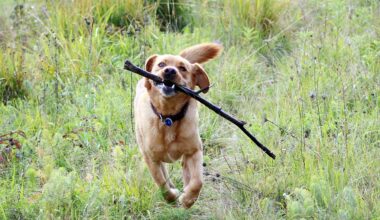Canine Hydrotherapy: Exercises and Benefits for Injury Recovery
Canine hydrotherapy is a specialized rehabilitation technique that enhances recovery in injured dogs. Water provides a safe and supportive environment, minimizing stress on joints and muscles while facilitating movement. Rehabilitation exercises in water can significantly improve strength, balance, and functionality. Dogs recovering from injuries, surgeries, or simply suffering from mobility issues benefit immensely from the buoyancy of water. Hydrotherapy is particularly effective for dogs with arthritis or joint problems. Apart from physical benefits, hydrotherapy also aids emotional recovery by creating a positive experience associated with rehabilitation. Engaging dogs in playful and gentle activities can lift their spirits. The warm water helps relax tight muscles and stimulates blood circulation. Additionally, dog hydrotherapy is conducted under the supervision of certified therapists, ensuring safety and effectiveness tailored specifically to each dog’s needs. Regular sessions complement traditional veterinary care, leading to enhanced outcomes. Investing time in hydrotherapy can promote quicker recovery while preventing chronic issues. To maximize results, owners should remain committed to a regular hydrotherapy schedule and follow a tailored exercise plan. By incorporating hydrotherapy, dog owners can witness significant improvements in their pet’s health and happiness during recovery.
The Importance of Hydrotherapy for Dogs
Hydrotherapy plays an essential role in the rehabilitation of dogs recovering from injuries or surgeries. This technique combines physical therapy principles with an enjoyable underwater environment. It enables dogs to undergo rigorous exercises safely while minimizing pain. Water supports the dog’s body weight, allowing for smoother movements and reducing stress on injured areas. Dogs can regain strength and muscle tone effectively without the risk of further injury. Hydrotherapy also promotes increased range of motion, which is crucial for recovery. Dogs that have experienced surgery may find it challenging to regain their normal mobility. The resistance of water provides all the benefits of exercise while allowing dogs to progress at their own pace. Regular hydrotherapy sessions can lead to remarkable improvements in pain management. Moreover, the warm water stimulates circulation and helps in tissue healing. Dogs that may be reluctant to exercise in a standard environment often thrive in a hydrotherapy setting. The soothing nature of water can also alleviate anxiety and stress related to their recovery. Beyond rehabilitation, hydrotherapy contributes to overall physical and mental well-being for dogs, making it a vital part of many veterinary treatment plans.
In addition to strengthening muscles, hydrotherapy exercises help focus on improving cardiovascular health in dogs. The water’s resistance requires more exertion than land exercises, resulting in enhanced heart and lung function. Dogs participating in hydrotherapy often exhibit higher levels of endurance after consistent sessions. This exercise method not only promotes physical advancement but also adds pace and excitement to the recovery process. Incorporating fun activities, such as fetching floating toys or navigating obstacles, keeps dogs engaged and motivated during therapy. Pet owners can play a significant role by encouraging their dogs throughout these sessions. It is crucial to work with professionals to create a personalized hydrotherapy plan addressing the specific rehab goals of the dog. Following the therapy, many dogs exhibit a willingness to resume their regular exercise routine much sooner. Effective coordination of a recovery program allows for a smoother transition back to normal activities. Pets who engage in hydrotherapy report less post-exercise soreness, resulting in happier, healthier dogs. The overall experience elevates their quality of life, minimizing the frustration pet owners may face when caring for an injured dog. As dogs progress, aquatic therapy proves to be an invaluable component of rehabilitation.
Types of Hydrotherapy Exercises
Hydrotherapy exercises can take various forms depending on the individual dog’s condition and comfort level. A common method is walking on a floating treadmill submerged in water. This promotes weight-bearing exercise while providing controlled resistance. Walking in water eases the strain on joints, allowing dogs to regain strength while engaging in natural movements. Another popular exercise is swimming, enabling dogs to get cardiovascular workouts without excess impact. Swimming sessions vary in intensity according to the specific rehab goals. Gentle exercises, such as fetching objects or navigating floating obstacles, can significantly enhance motivation and engagement. Incorporating games can also encourage active participation and make the therapy enjoyable for the dog. For dogs with mobility issues, passive range-of-motion exercises performed by therapists provide essential benefits too. Owners can also practice hydrostatic pressure techniques to stimulate joints and muscles, ensuring the safety of recovery. The use of flotation devices can assist less confident dogs while building their swimming skills and promoting independence. Combining a variety of hydrotherapy methods keeps the rehabilitation experience dynamic and effective for each dog. All exercises should be tailored based on specific rehabilitation goals to ensure success.
Consistency is crucial to the success of canine hydrotherapy. Regular practice allows dogs to make steady progress toward their rehabilitation goals. It is recommended to schedule multiple sessions per week, tailoring frequency based on the dog’s unique recovery timeline. This consistent engagement helps dogs rebuild strength, flexibility, and range of motion. Owners should also monitor their dog’s responses to different exercises, adjusting the plan as needed. Maintaining open communication with the veterinary team is essential to ensure optimal recovery. Utilizing professionals who specialize in canine hydrotherapy guarantees safety and effectiveness during sessions. Rehabilitation goals should also include both physical and emotional aspects for a comprehensive approach. Emotional support for the dog can enhance success rates, allowing them the freedom to explore their environment. Positive reinforcement, like treats or praise during and after sessions, helps create a rewarding atmosphere. One reasonable goal for owners is to observe their dog’s improvements consistently, adjusting expectations accordingly. Making hydrotherapy a regular aspect of rehabilitation also encourages pet owners to participate actively in their dog’s recovery. While the results may vary, dedication from both owners and therapists leads to happier, healthier dogs that can achieve remarkable recoveries.
Safety Considerations in Hydrotherapy
While canine hydrotherapy offers numerous benefits, safety measures must be prioritized. Monitoring the dog’s health is key to effective rehabilitation. Prior to starting hydrotherapy, dogs should receive comprehensive evaluations by their veterinarian to identify any underlying health issues. Specific conditions, such as heart problems or severe skin infections, might render them unsuitable for treatment. Professional hydrotherapists are essential in ensuring safety during sessions. These experts create safe environments and supervise activities to prevent injuries and ensure appropriate techniques are applied. Owners should be aware of their dog’s physical and emotional state during sessions. Signs of fatigue or discomfort should be addressed promptly. Warm-up and cool-down periods are also vital in mitigating potential injuries. Gradual transitions into water are recommended to prevent anxiety. Proper equipment, such as life vests, may be necessary depending on the dog’s swimming abilities. Additionally, owners should be informed about the importance of keeping hydroptherapy sessions enjoyable to foster a positive attitude during treatment. All safety factors combined ensure that dogs receive the most effective rehabilitation without unnecessary risks. Following established protocols safeguards both the dog’s well-being and the therapy’s success.
Canine hydrotherapy also serves as a preventative measure for various health issues. Regular sessions enhance overall fitness and help maintain an ideal weight. Many dogs are prone to obesity, which can lead to joint problems and other health complications. Hydrotherapy promotes proper muscle development while supporting loss or maintenance of body weight. Furthermore, it can function as a maintenance therapy, keeping dogs in peak physical condition post-recovery. Engaging in regular hydrotherapy can prevent the recurrence of injuries. This preventative approach is vital for active breeds or dogs involved in agility sports. By integrating hydrotherapy into a long-term healthcare routine, owners can safeguard their pets’ physical and emotional well-being. Although hydrotherapy may primarily focus on rehabilitation, all dogs can benefit from it throughout their lives. The best part is that many facilities combine hydrotherapy with other modalities, such as acupuncture or standard physiotherapy, for a complete wellness approach. Finding a suitable center can enhance the effectiveness of the program, yielding long-term improvements. Therefore, hydrotherapy should be recognized as a valued enhancement to a dog’s health, offering benefits that extend beyond rehabilitation into a more fulfilling, active life.
In conclusion, canine hydrotherapy stands as an effective therapeutic method for dogs recovering from injuries while simultaneously providing numerous advantages for overall health. By engaging dogs in a supportive aquatic environment, hydrotherapy reduces stress on joints and enhances mobility. The importance of incorporating various exercises tailored specifically to the dog’s needs cannot be understated. Regular participation fosters strength, flexibility, and encourages emotional well-being. Owners should remain committed by scheduling consistent sessions while providing encouragement. The expertise of certified professionals ensures the safety and success of hydrotherapy routines. The program not only aids in recovery but can also prevent future injuries. Dogs participating in hydrotherapy often exhibit improved cardiovascular and muscular health, which correlates with longevity. By maintaining durable routines, pets experience an enhanced quality of life through more effective management of their health. Canine hydrotherapy is a holistic solution, merging physical and mental health benefits in one comprehensive approach. As pet owners, recognizing the value of incorporating activities such as hydrotherapy into a dog’s overall wellness plan may lead to years of joyful companionship and healthier lifestyles. Ultimately, investing in canine hydrotherapy proves advantageous for both pets and their owners in their shared journeys toward recovery.


